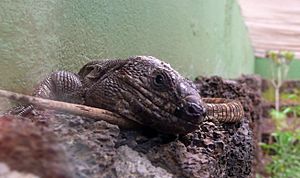El Hierro giant lizard facts for kids
Quick facts for kids Hierro giant lizard |
|
|---|---|
 |
|
| Conservation status | |
| Scientific classification |
|
| Kingdom: | Animalia |
| Phylum: | Chordata |
| Class: | Reptilia |
| Order: | Squamata |
| Family: | Lacertidae |
| Genus: | Gallotia |
| Species: | |
| Subspecies: |
G. s. machadoi
|
| Trinomial name | |
| Gallotia simonyi machadoi Lopez-Jurado, 1989
|
|
| Synonyms | |
|
See text |
|
The El Hierro giant lizard (Gallotia simonyi machadoi) is a special type of lizard that lives only on the island of El Hierro. This island is one of the Canary Islands, which are off the coast of Africa. This lizard is a subspecies of a larger group called Gallotia simonyi, also known as Simony's lizard.
These lizards used to live all over El Hierro and on a small nearby island called Roque Chico de Salmor. Now, they are found in only a few small areas. These areas are mostly cliffs with not many plants. They are currently found at the southern end of the Risco de Tibataje. This area is about four hectares big. In 1999, some lizards were successfully moved back to Roque Chico de Salmor. More lizards have also been reintroduced to other places like Julan and la Dehesa.
What Does It Look Like?
The Hierro giant lizard can grow to be about 60 centimetres (2.0 ft) long. It is a strong reptile with a wide head. Adult lizards are dark grey to brown. They have two rows of light orange spots along their sides. Their belly is mostly brown, but it turns orange or red in the middle. Older lizards are mostly black with some grey. Male lizards are usually bigger than females. This lizard is a special animal symbol for the island of El Hierro.
What Does It Eat?
The Hierro giant lizard eats both plants and animals. This means it is an omnivorous animal. It likes to eat plants like verode and Lavandula abrotanoides. It also eats insects.
Mating season for these lizards starts in May. Females lay about 5 to 13 eggs from June until the end of August. The eggs hatch after about 61 days.
Protecting the Hierro Giant Lizard
In 1974, a German animal expert named Werner Bings found a group of these lizards still living on El Hierro. This was exciting because people thought they might be gone. Later, scientists realized these lizards were a special subspecies.
There are only about 300 to 400 Hierro giant lizards left in the wild. This includes the ones that have been moved back to their natural homes. Because there are so few, this lizard is listed as critically endangered. This means it is at a very high risk of disappearing forever.
The biggest danger to these lizards is being hunted by wild cats. They might also be hunted by dogs and rats.
A special plan has been made to help the Hierro giant lizard. The United Nations and the government of the Canary Islands have helped fund a program. This program raises lizards in special centers. Then, they release them back into their natural homes. This includes Roque Chico de Salmor. For a while, the control of wild cats was stopped. However, experts now say that controlling the wild cats needs to start again. This will help the lizard population grow.
The Hierro giant lizard is protected by laws both in Spain and around the world. It is listed in important agreements like the European Union's Habitats Directive and CITES. These laws help make sure the lizards are not harmed or traded illegally.
See also
 In Spanish: Lagarto gigante de El Hierro para niños
In Spanish: Lagarto gigante de El Hierro para niños




